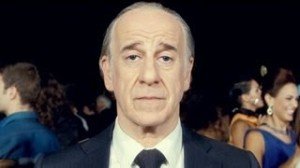Is It a Beauty? Is It Great?
Paolo Sorrentino, The Great Beauty (La Grande Bellezza) (2013)
If you’re having one of those days in which you’re wondering what life’s all about, Paolo Sorrentino’s masterful The Great Beauty may not be the film for you. It’s not exactly reassuring. However, if you’re looking for a movie that renews your faith in the emptiness of existence, you’ve come to the right place.
Italian director Sorrentino’s Oscar-winning picture for Best Foreign Language Film (as well as the winner of the Golden Globe and Bafta awards in the same category) begins with a bit of visual slapstick that plays on the traveler’s old romantic saw, “See X and die.” The original version of the Italian pop saying is, “See Naples and die,” but it’s been mistakenly, though for good reason, transmuted so often into “See Rome and die,” that most people don’t know the difference. A female choir is singing, perched on a balcony above Pope Paul V’s 17th century fountain, Fontana dell’Acqua Paola, atop Rome’s Janiculum hill. A group of Japanese tourists is gathered at the foot of the fountain’s pool as the tour guide explains it all. But one beefy visitor from Asia momentarily turns away, crosses the lane to snap some photos of the view of the Roman panorama from the hilltop, and promptly keels over, whether in a faint or terminally expired is never made clear. Welcome to The Great Beauty.
That’s the last we see of the tourists. Sorrentino immediately pitches us into the scream-shattered night and a raucous 65th birthday party for journalist and long ago promising novelist Jep Gambardella, played with enigmatic detachment, sardonic smiles and ineffable melancholy by Toni Servillo. Servillo is the 43-year-old director’s favourite leading man and starred in Sorrentino’s heretofore best-known film, Il Divo (2008), about the Italian politician Giulio Andreotti. In fact, Servillo has a relationship to Sorrentino’s films that parallels the earlier partnership between director Federico Fellini and actor Marcello Mastroianni in La Dolce Vita (1960) 8 1/2 (1963) and a dozen other works from a half-century ago. (I’ll get to Fellini/Sorrentino in a minute.)
At the outset of La Grande Bellezza, “trains” of conga dancing guests, moving to the beat of electro-pop mixes and a live mariachi band, are snaking their way around the cast-of-hundreds-sized rooftop terrace of Jeb’s swanky apartment, which is located just across the road from the ancient Roman Colosseum, while in the black sky a nearby Martini’s vermouth neon sign hovers like a moon over both the arena of ancient gladiators and the bacchanalia of ghosts from the Via Veneto.
For one radiant moment, a grinning, gyrating Jep, cigarette clamped between his teeth, turns to us seemingly suffused in bliss, as if to declare that life’s a perpetual party. But a couple of moments later, Jep steps out between the lines of frantic dancers, lights another cigarette, and as the dancers fade into slow motion, he dons his more habitual mask of “polite disenchantment” (as one critic, the Guardian’s Peter Bradshaw, aptly calls it), and memory’s voice-over says, “When I came to Rome at the age of 26, I fell pretty swiftly, almost without realising it, into what might be defined as the whirl of the high life. But I didn’t want just to live the high life, I wanted to become its king.”
Be careful what you wish for. Over the next two hours plus, in a series of both magical and grotesque vignettes, populated by a surreal cast that includes an elegant and maternal editor of the paper Jep writes for (oh yes, she happens to be a dwarf), a Maria Abramovic-like performance artist named Talia Concept who bashes her noggin into the Roman aqueduct, a New Age-y botox cosmetician who conducts something closer to seances than a clinic (injections are a thousand dollars a pop), and a 104-year-old Mother Teresa-style “living saint,” Sorrentino presents a brooding, bopping portrait of a middle-aged, upper and/or chattering class, Berlusconi-era contemporary Italy.
There are strippers, suicides, a magician who makes a giraffe disappear, memories of sexual initiation, secrets of desire revealed too late, a cardinal tipped to be the next pope who would rather discuss recipes for rabbit stew than spiritual qualms, and those “trains” of bronzed and botoxed dancers in their 40s, 50s, 60s, pretending to defy mortality. It’s a crowded canvas. A lot of critics routinely applied the adjective “overlong” to this film, but I have to say that Sorrentino (and cinematographer Luca Bigazzi) kept me so busy with spectacular visuals and putting the jigsaw pieces of plot together that I don’t recall a moment of disinterest or any longing to check my Facebook status.
There are just enough pauses in the frenzy for a meditative dawn stroll along the Tiber, or a morning after when the flamingo flock roosting on Jep’s terrace wakes and takes flight. As in Woody Allen’s bucolic version of New York, this is a Rome devoid of traffic, laborers, ubiquitous tourists, or other mundane distractions. Sorrentino’s urban landscape revels in the classical as well as baroque buildings, fountains, and monuments of the Eternal City. If nothing else lives up to the definition of la grande belleza, Rome itself will do.
The Great Beauty is a film about the recognition and resigned acceptance of wasted life, both Jep’s and that of a stymied contemporary Italy. Jep made the journey from his hometown of Naples to Rome (Sorrentino’s life took a similar path) as the author of a powerful debut novel, The Human Apparatus, praised even by the great Alberto Moravia, as Jep remarks in passing to a woman friend. But there was never a second book. A sort of running gag of the film is that Jep is asked by everyone, from his dwarf editor to the 104-year-old nun who’s appeared with a PR minder in tow for a celebrity dinner at Jep’s apartment, Why didn’t you write another book? And each time he fashions a self-deprecating answer. The fullest version of that answer comes near the end:
“I was looking for ‘La Grande Bellezza’ and I didn’t find it… This is how it always ends, with death. But first there was life, hidden beneath the blah, blah, blah. It is all settled beneath the chitter chatter of the noise, the silence and the emotion and the fear, the haggard, inconstant beauty and then the wretched squalor and the miserable humanity… There, let this novel begin. After all, it’s just a trick. Yes, it’s just a trick.”
If the sense of loss conveyed by The Great Beauty were simply that of Jep’s defeat at the hands of the enemies of promise or confined to the self-delusions of his circle, Sorrentino would have limited himself to hard-edged satire, which is not bad, but perhaps not moving. If his protagonist and some of the others elicit sufficient empathy, however, then the film finds its resonance and poignancy in the self-recognition of how our own lives have gone. But this is where the receptive divide begins.
For cinephiles, another layer of meaning is to be found in the relationship between Sorrentino’s film and Federico Fellini’s half century old La Dolce Vita. Just about all of the critics, almost without exception, dutifully mention the connection, only to pass over any discussion of its dialectical twists. The critics simply assume knowledge of Fellini (1920-93) and his films, which is a safe bet for readers of these pages, but for those of us who measure shared cultural content by, say, the minds of first-year university students, it’s not a to be taken for granted assumption. When I surveyed students in a philosophy and culture course last fall, not one of them had seen a film by Fellini, Godard, Bergman, Truffaut, Bunuel, Resnais or Antonioni. Not one. Well, maybe one or two, but they were just too shy to say so. They also thought 50 years ago was ancient history, even if their professor regarded it as memory.
Fellini’s Dolce Vita was an expose of the intellectual, artistic, and social decadence and pretensions of Rome at the beginning of the booming 1960s. The Great Beauty is a remarkable, explicit homage to Fellini’s Dolce Vita, picking up on almost all the themes and images of the earlier film, from religion to intellectual and social life to the parties and splashings in the fountains. It is an homage, yes, but at the same time it is an historical update and an original “remake,” if there is such a category. The effect is to produce an optical illusion in which you feel like you’re seeing La Dolce Vita again, but somehow for the first time, and simultaneously a new film as well.
In terms of the update, there are historical and economic differences to account for. Alexander Stille, author of The Sack of Rome (2007), his book about Silvio Berlusconi, and one of the more knowledgeable commentators on contemporary Italy, observes that if the character Marcello, the young journalist played by Marcello Mastroianni in Fellini’s Dolce Vita, “had spent another four decades flitting about the high life of Rome he might have turned into someone like Jep Gambardella.” Stille recalls that “the opening of La Dolce Vita showed a giant statue of Christ being flown across the skies of Rome by helicopter, with Marcello and fellow journalists following in a second helicopter and trying to communicate by gesture with girls sunbathing on the roofs of the city’s new high-rise buildings as they pass by. Fellini appeared to send a clear message: that his film was describing the uneasy and deeply strange transition of a traditional, rural, Catholic society into the wild and amoral world of the ‘economic miracle’ of the 1960s. By contrast, [Sorrentino]… seems to be showing us a Rome whose population has succumbed to a random and increasingly meaningless existence…”
Fellini’s Italy “was frivolous but vital; it was a society that was both ancient and young, with the energy and silliness of youth,” whereas Sorrentino’s film is “an expression of the disorientation and disenchantment of a country that seems to have lost its way and its belief in itself.” (Alexander Stille, “Dancing to Nowhere,” New York Review Blog, Jan. 9, 2014.)
Rachel Donadio, who interviewed Sorrentino in Rome last fall, where the film had been the talk of the town all summer, makes a similar point. “More than any other film to emerge from Italy in recent years,” she says, “The Great Beauty explores one of the most difficult questions in Italy today: What happened here? How did this country… reach the languorous impasse at which it finds itself now? How did it become this strange hothouse where the debate [in Parliament] revolves around whether applying the rule of law, a conviction against the former prime minister Silvio Berlusconi for tax fraud, puts the country’s stability ar risk?” (Rachel Donadio, “La Dolce Vita Gone Sour (and This Time in Color),” New York Times, Sept. 8, 2013.) Six months after writing that, Italy’s stability remains fragile, both economically and in terms of even cobbling together a government to administer the chaos.
Sorrentino reiterates this thesis. In contemporary Rome, he told Donadio, “It’s hard to be positive, there’s a kind of lassitude that found its symbolic culmination in dancing, in conga lines, in trying to seduce the beautiful woman of the moment or the beautiful man of the moment… Obviously, it’s not only like that,” Sorrentino added, “There are lots of people who work and do wonderful and commendable things, but there’s still a sense that the nerve centers of the country had fallen asleep on their couches at home.” While La Grande Bellezza is not a political film per se, Donadio argues that Sorrentino is one of the few directors “to engage fully with the culture of excess that has come to characterize the Italy of Berlusconi,” who was prime minister, most recently, until 2011.
Whether the film accurately encapsulates its time, whether its intimate relation to Fellini’s body of work is genuine, and whether, as I say, it elicits those self-recognitions about life that lend art its broader relevance, is where the divide over The Great Beauty’s critical reception commences.
As Corriere della Serra columnist Beppe Severgnini remarks, “The world loves all things Italian, but the same cannot always be said of Italians.” That’s the case, apparently, with Sorrentino’s film. “The world loves it; Italy, not so much — a fact that says a lot about how the world sees my country, but even more about how my country views itself.”
Although the film’s been widely praised and much-honored, “Italian critics, though, aren’t having it,” Severgnini reports. “It is pretentious, anachronistic and vapid, they say.” One local paper argued that Fellini’s 1960 film was criticized because it was ahead of its time, but Sorrentino’s film “lags behind, clinging to the Sad ’70s.” Even Severgnini’s own paper groused that “the over-affected literary dialogue ends up sounding verbose to the point of sententiousness.” As for the columnist himself, “I’ve seen the film — twice — and I have to say I’m with the non-Italians. I’m also interested in why my country is getting so worked up about it… The Great Beauty rubs many Italians the wrong way because it disturbs them, and is a hit with non-Italians because it fascinates them.” (Beppe Severgnini, “Beauty Among the Ruins,” New York Times, Feb. 10, 2014.)
Admittedly, Sorrentino’s Rome is not the Rome even of all Romans. When Alexander Stille met a young couple from Rome complaining about how hard life was there, he replied, trying to sound a positive note, “‘Of course it’s a beautiful city.’ They looked at me a bit perplexed. They lived out on the periphery, amid ugly high-rises, with poor public transportation and snarling traffic jams; they rarely came into the city center where all the beautiful monuments are. They inhabited a different Rome from the one… Sorrentino shows.” Even mere spectators will wonder how Jep Gambardella is able to afford a penthouse next door to the Colosseum on what seems to be occasional celebrity journalism and a 40-year-old one-off best-seller novel. As for anachronisms, isn’t the film a bit short on cellphones, tablets and other distracting devices? Do Italians spend that much time in conversation rather than gazing at screens in the palms of their hands? And are they still smoking so much in Italy? Oh well.
Sorrentino, who’s been living in the midst of the debate, told reporter Donadio, “The film makes you face questions that might be irritating. There’s a tendency among Italians to say: ‘We’re not part of that,’ ‘I’m not part of that.’ Many people went out of their way to say that they weren’t part of it, and they were the ones who were most a part of it.”
With so many viewers and critics believing that from a bleak reality, Sorrentino has fashioned a redemptive work of art that lives up to its implicit eponymous promise, maybe some of the last words should go to someone who thinks precisely the opposite. Unsurprisingly, some critics found this “episodic tour of Jep’s banal reflections on his life” merely pretentious pap. “Judging from the quality of his prose, which Jep intones at times in voice-over, he probably made the right choice after all” in opting to be an arbiter of taste rather than an artist. “In lieu of writing his next great novel, Jep wanders Rome gazing at beautifully shot nudes with an expression of knowing melancholy… Or he lounges at soirees and acts like a pompous boor, insulting women, exposing phonies, and waxing eloquent about life, transcience, and the irony of it all. Cigarette in hand, his face reflecting sentimentality and arrogance, [Jep] has all the flaws, but none of the beauty of his counterpart in La Dolce Vita,” declares an unforgiving Peter. Keough, who sees only pomposity where others observe a sense of loss amid the literal and metaphoric ruins. (Peter Keough, “Fellini homage is no ‘Beauty,'” Boston Globe, Nov. 28, 2013.) Oh well, not for everyone.
Most critics were rather more sympathetic. Robbie Collins asks whether The Great Beauty can “really stand alongside” comparable Italian cinematic masterpieces, and advises us to “check back in half a century. Until then, all that matters is that it might, and theoretically could.” Collins recalls that “when the credits began to roll at the press screening at the Cannes Film Festival [last] May, some critics rose to their feet and just stared dumbly at the screen. I’m happy to admit I was among them.” (Robbie Collins, “The Great Beauty, a shimmering coup de cinema…”, The Telegraph, Jan. 13, 2014.) While the credits are rolling, a riverboat seen earlier in the film takes you up the bucolic Tiber River. Guardian critic Peter Bradshaw advises, “And for all its intense, unbearable melancholy, the final end-title sequence has to be watched through to the very end until the screen goes dark.”





